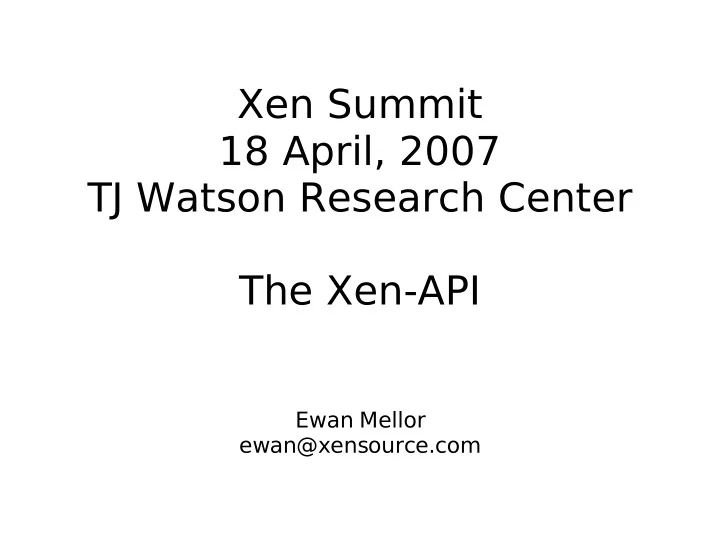

Xen Summit 18 April, 2007 TJ Watson Research Center The Xen-API Ewan Mellor ewan@xensource.com
Xen Management Architecture Cluster-wide Integration The aim is to integrate Xen-based systems with enterprise-level cluster management solutions. These solutions will use CIM as the integration interface. The Xen-CIM effort is of paramount importance. Xen-CIM needs a stable interface into Xend.
Xen Management Architecture Lightweight Management We further aim to make it possible to manage Xen-based systems remotely, without enterprise- level solutions. Build an ecosystem of third-party tools around Xen. Keep the interfaces stable over the long term, allowing these tools to mature. Red Hat's virt-manager is the first major application in a position to use the Xen-API, as a libvirt backend.
Xen Management Architecture xeninfo virt-manager Xen-CIM xm (Ingard Java-based libvirt Mevåg) Apache libxen (C bindings) pyxen RPC::XML XML-RPC Xen-RPC over HTTP or HTTPS Xend Host Xenstore Xen Utilities
Xen-API Class Hierarchy
Xen-API Basic Example session_ref = session.login_with_password('ewan', 'hello') vm_list = VM.get_all(session_ref) for vm_ref in vm_list: vm_record = VM.get_record(session_ref, vm_ref) print “VM name:” + vm_record.name_label VM.start(session_ref, vm_ref, false) vbd_list = VM.get_VBDs(session_ref, vm_ref) for vbd_ref in vbd_list: ...
VM Lifecycle xm new xm delete VM.create VM.destroy Stopped xm start xm shutdown / xm destroy VM.start VM.clean_shutdown / VM.hard_shutdown xm pause xm reboot VM.pause VM.clean_reboot Paused Running xm unpause VM.unpause Note, there are xm suspend xm resume no transition states VM.suspend VM.resume Suspended
Retrieving Metrics ~ # xm shell The Xen Master. Type "help" for a list of functions. xm> VM_metrics.get_record 53b59b27-adeb-855e-8ea3-a50d4e3b9824 {'VCPUs_CPU': {'1': '1', '0': '0', '3': '1', '2': '0'}, 'VCPUs_flags': {'1': [], '0': ['online'], '3': [], '2': []}, 'VCPUs_number': '1', 'VCPUs_params': {'cap': '0', 'cpumap0': '0, ...', 'cpumap1': '0, ...', 'cpumap2': '0, ...', 'cpumap3': '0, ...', 'weight': '256'}, 'VCPUs_utilisation': {'1': 0.0, '0': 0.124, '3': 0.0, '2': 0.0}, 'last_updated': <DateTime u'20070418T13:02:39' at 2aaee5c37ea8>, 'memory_actual': '268304384', 'start_time': <DateTime u'20070418T12:59:49' at 2aaee5c37b90>, 'state': [], 'uuid': '53b59b27-adeb-855e-8ea3-a50d4e3b9824'} VIF, VBD, PIF also have metrics Bandwidth values are averages over the last second
Error Handling All calls return an XML-RPC structure: Status: “Success” Value: <the result> or Status: “Failure” ErrorDescription: [“VM_BAD_POWER_STATE”, “Halted”, “Running”] The first element of the list is the error code. Each error code has parameters specific to that code. Error messages can then be internationalised on the client-side. pyxen captures the Status: Failure and creates an exception. libxen saves them on the session object.
Asynchronous Callbacks ● “Blocking poll” for receiving callbacks – event.next() ● The client uses their existing HTTP client library ● No need to open a socket in the client Simple event model: ● This field on this object has changed ● An object was created ● An object was destroyed Registration on a per-class granularity
Asynchronous Callbacks xm event-monitor: server.xenapi.event.register([]) while True: events = server.xenapi.event.next() for e in events: pprint.pprint(e) {'class': 'VM', 'field': 'power_state', 'id': '3', 'obj_uuid': '8ef25b6f-889f-a1e0-6312-4bb532ed7d3f', 'operation': 'mod', 'ref': '8ef25b6f-889f-a1e0-6312-4bb532ed7d3f', 'timestamp': <DateTime u'20070418T12:59:49' at 2aef2111a3b0>}
Configuration Xen-API XML-RPC over HTTP / TCP on port 9363, using PAM and an allowed-hosts specifier In /etc/xen/xend-config.sxp: (xen-api-server ((9363 pam '^localhost$ example\\.com$') (9367 pam '' /etc/xen/xen-api.key /etc/xen/xen-api.crt) (unix none))) HTTP over TLS over TCP on Xen-API XML-RPC over a port 9367, using PAM and Unix domain socket at the specified keys /var/run/xend/xen-api.sock, unauthenticated
Example in C xmlInitParser(); xen_init(); curl_global_init(CURL_GLOBAL_ALL); xen_session *session = xen_session_login_with_password(call_func, NULL, username, password); xen_vm vm; if (!xen_vm_get_by_uuid(session, &vm, uuid)) { /* Error */ } xen_vm_record *vm_record; if (!xen_vm_get_record(session, &vm_record, vm)) { /* Error */ } if (!xen_vm_start(session, vm)) { /* Error */ }
On-wire Example xen_vm_record *vm_record; if (!xen_vm_get_record(session, &vm_record, vm)) { <?xml version='1.0'?> <methodCall><methodName> Vm.get_record </methodName><params> <param><value><string> 12345678-abcd-ef90-123456789abc </string></value></param> </params></methodCall> <?xml version='1.0'?> <methodResponse><params> <param><value><struct> <member><name> Status </name><value><string> Success </string></value></member> <member><name> Value </name> <value><struct> <member><name> name_label </name> <value><string> My VM </string></value></member> <member><name>boot_method</name> <value><string> kernel_external </string></value></member>
Perl Example require RPC::XML; From Ingard Mevåg's require RPC::XML::Client; xeninfo script. sub get_host_mem_utilisation { my ($xen, $session, $host_name, $host_ref) = @_; my $host_metrics_ref = validate_response($xen->simple_request("host.get_metrics", $session, $host_ref)); my $host_mem_total = validate_response($xen->simple_request( "host_metrics.get_memory_total", $session, $host_metrics_ref)) / 1024 / 1024; my $host_mem_free = validate_response($xen->simple_request( "host_metrics.get_memory_free", $session, $host_metrics_ref)) / 1024 / 1024; $host_info{$host_name}{'memory'} = {'total' => $host_mem_total, 'free' => $host_mem_free}; print "Total: $host_mem_total MB – Free: $host_mem_free MB\n"; }
Java Example Using Apache's Object [] params; XML-RPC library. HashMap<String, Object> result; URL url = new URL("http://my.machine:9363"); XmlRpcClientConfigImpl config = new XmlRpcClientConfigImpl(); config.setServerURL(url); XmlRpcClient client = new XmlRpcClient(); params = new Object [] {"ewan", "hello"}; result = (HashMap)client.execute("session.login_with_password", params); String session_ref = (String)result.get("Value"); params = new Object [] {session_ref}; result = (HashMap)client.execute("VM.get_all", params); Object [] arr = (Object [])result.get("Value"); int i; for (i = 0; i < arr.length; i++) { Adapted from System.out.println("VM ref: " + (String)arr[i]); Stefan Berger's } recent xen-api post.
Future Work Release Xen-API 1.0, with Xen 3.0.5. Integrate XSM/ACM and XSM/Flask. Add raw counters to our metrics classes. Add support for grabbing crash dumps. Add bindings for other languages. (What do people want?) More examples and documentation. Mailing list: xen-api@lists.xensource.com Wiki: http://wiki.xensource.com/xenwiki/XenApi Documentation: xen-unstable.hg/docs/xen-api C bindings: xen-unstable.hg/tools/libxen Python bindings: xen-unstable.hg/tools/python/xen/xm/XenAPI.py
Recommend
More recommend